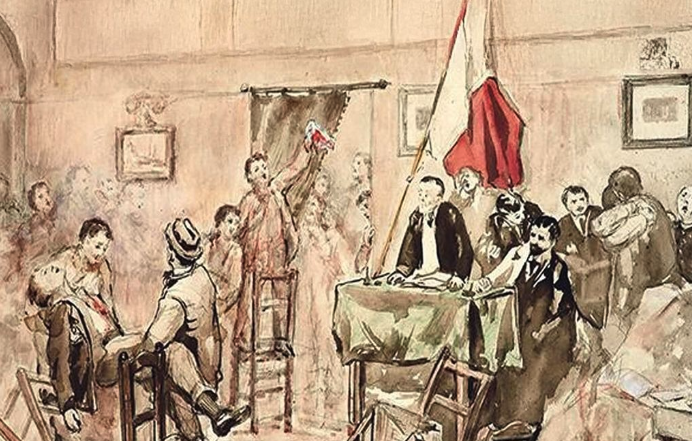The Maltese flag, simple in design but rich in history, tells the story of a small yet resilient island nation. It has evolved alongside the country’s journey to independence. Today, it stands as a symbol of national pride, sovereignty, and historical endurance, but this was not always the case. The flag has undergone many transformations over the centuries, each carrying its own historical baggage, with fierce debates surrounding its symbolism.
Count Roger’s Myth
The story of the Maltese flag begins with one of Malta’s most enduring legends — the tale of Count Roger of Normandy. According to an 1841 pamphlet by Dr. Gaetano Laferla, when Count Roger liberated Malta from Arab rule in 1090, he granted the Maltese people the right to use the red and white from his coat of arms. These colors would later become the hallmark of Malta’s national emblem and flag. However, historians have long debated the accuracy of this tale, as no solid documentation exists to support it. Some recent findings suggest that the flag’s colors may have been a gift from King Alphonse V of Spain during his visit to Malta in 1498. Despite the uncertainty, the red and white stripes have been accepted for centuries as a symbol of the Maltese Commune, and they remain an integral part of Malta’s national identity.
The Knights and the French
The red and white colors on the Maltese coat of arms appear to have been accepted during the rule of the Order of St John. No reservation is known to have ever been imposed on their use. Historian Michael Ellul states that, given that the colors of the Order incorporated both the red and white colors, this may have been a significant factor in their acceptance. The colours were allegedly also used during the Maltese revolt against the French in 1798. This flag was raised in Mdina shortly after the uprising began and reflected the desire for national identity tied to the traditional Maltese Commune.
The Push for Self-Government
Malta’s journey towards self-government saw increasing demands for the national flag to be recognized and flown. After Malta gained self-government in 1921, Enrico Mizzi, a fervent nationalist and leader of the Partito Democratico Nazionalista, became a key figure in advocating for the national flag’s prominence. In 1922, Mizzi tabled a resolution in the Legislative Assembly calling for the Maltese flag to be raised alongside the British one on public holidays. His speech, although accused of historical inaccuracies, was met with overwhelming support, reflecting the growing sentiment of national pride.
During this period, however, the use of the national flag remained limited. The colonial government favored the Blue Ensign with a Maltese badge, and debates over Malta’s national identity often took a back seat to the language question, with factions fighting over whether Italian or English should be the official language of the island. The flag, despite its symbolic importance, became a secondary issue in the broader political discourse.
The George Cross
The defining moment in Malta’s national symbolism came during World War II. In recognition of the island’s bravery in withstanding relentless Axis bombing, King George VI awarded the George Cross to Malta on 15th April 1942. This was a unique honor, as it marked the first time the award had been given to an entire population. The George Cross became a symbol of Malta’s courage, and the idea arose to incorporate the medal into the national coat of arms.
In 1943, the British government proposed several designs to superimpose the George Cross onto Malta’s existing coat of arms, leading to much debate. By December 28, 1943, King George VI issued a Royal Warrant officially incorporating the George Cross into Malta’s coat of arms, placing it in the top left corner. However, this decision was reportedly made with little consultation with the Maltese government, sparking frustration over the lack of local involvement in what many considered a crucial national symbol.
Independence and the Flag’s Final Form
The real turning point for the Maltese flag came in the 1960s as Malta approached independence. During these years, debates about the flag were heavily tied to the movement for sovereignty. With independence granted in 1964, the flag took on a new significance. The blue border that had once represented colonial British influence was replaced with a red border around the George Cross, symbolizing Malta’s newly attained independence.
Article 3 of the 1964 Constitution enshrined the flag in law, stating that Malta’s flag would consist of two vertical stripes, white and red, with the George Cross displayed in the canton of the white stripe, edged in red. On September 21, 1964, during the Independence ceremony, the Union Jack was lowered, and the Maltese flag was raised, symbolizing Malta’s full sovereignty.
A Lasting Symbol of Sovereignty
Today, the Maltese flag is a proud reminder of the nation’s struggle for identity, freedom, and self-determination. It carries with it centuries of history, from the myth of Count Roger to the award of the George Cross, and the eventual triumph of independence. While the road to sovereignty was long and fraught with challenges, the flag that now flies over Malta is a testament to the resilience and courage of its people, representing not only a nation but a story of perseverance and pride.
In this context, the flag’s simple design takes on an extraordinary meaning, embodying Malta’s journey from a small island under foreign rule to a proud, independent republic. Whether seen fluttering over Fort St. Angelo, or in the hands of patriotic citizens, the red and white stripes continue to serve as a powerful symbol of Malta’s past, present, and future.

Leave a Reply